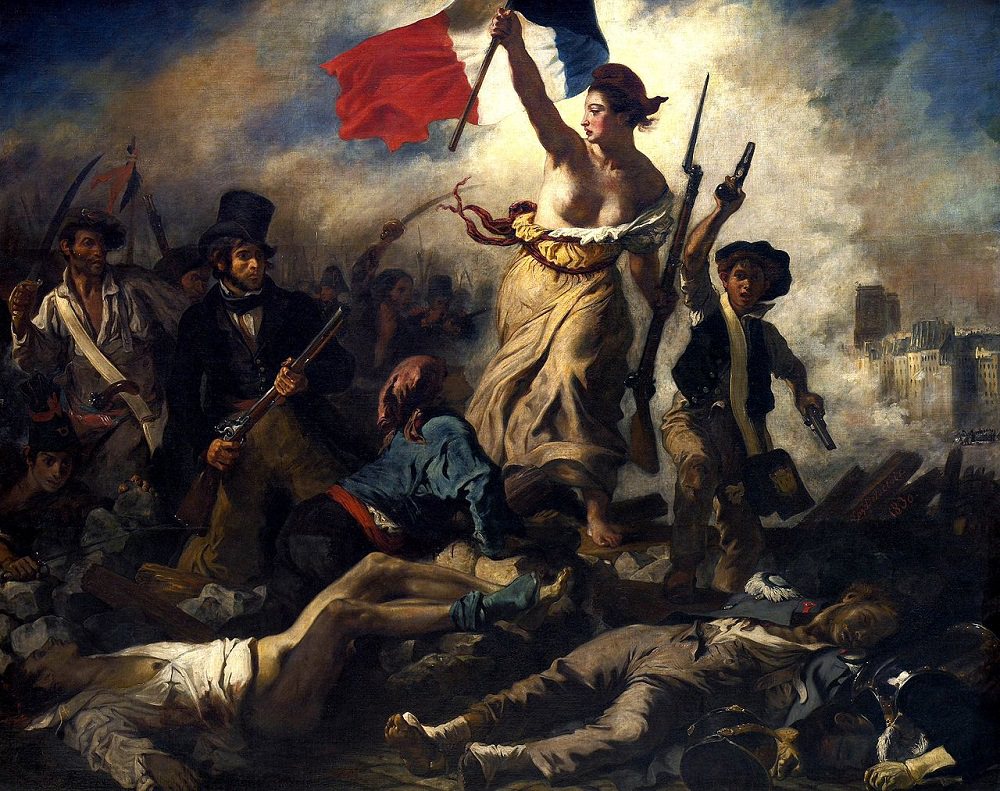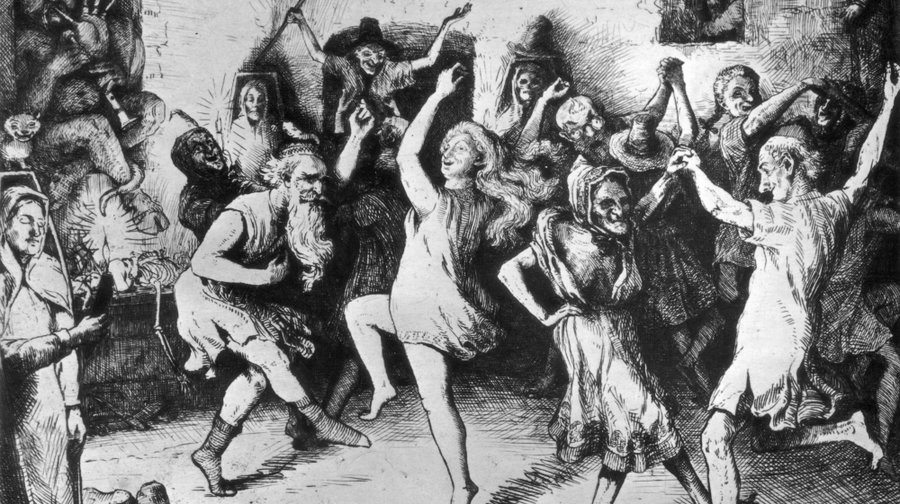During the Revolutions of 1830, romantic artists responded to economic recession and political conflict with a number of aesthetic, emotional, and formal deviations in their work. Reflecting on pieces by Eugene Delacroix and Hector Berlioz, we can uncover intent to evoke reactions in individuals and empower revolutionaries with these artistic decisions.
The events leading to the Revolution of 1830 primarily included Napoleon Bonaparte’s conquest through Europe. Following his self-coronation in 1804, Napoleon’s reign lasted until 1815, where defeats in Russia and Leipzig led to his exile. The Allied powers devised the Treaty of Chaumont in 1814 and convened at the Congress of Vienna to try to put a stop to Napoleon’s warfare and redraw state boundaries. Most importantly, the Bourbon monarchs returned to the French throne with the formation of a constitutional monarchy. Louis XVIII took the throne, with a brief period in 1815 when Napoleon tried to stage an unsuccessful uprising. Charles X then took the throne in 1824. Economic recession and agricultural tariffs in 1827 to 1830 led to Charles’ controversial ordinances. One of the changes that abolished the Chamber of Deputies led to massive protest and strike. Following the July Revolutions, Charles X abdicated and Louis-Philippe took the throne.
In the 1820s, Romantic artists like Eugene Delacroix wanted to explore themes of nature, human mood, and suffering. Works like “The Barque of Dante” (1822) and “The Massacre at Chios” (1824) received mixed reviews for their gritty portrayals of death. One critic even labeled it a “massacre of art” (Delacroix). Other works like “The Death of Sardanapalus” (1827) continued this trend of intense contorted movement and use of vivid colors and brush strokes. One of the most popular works of Delacroix is “Liberty Leading the People” (1830), which depicts the July Revolutions of that year. Especially in this piece, we see Delacroix’s blending of classical and romantic elements. As one source notes, “[Neoclassicism] was an art that strove to preserve values thought to descend from ancient Greece and Rome. On the other was Romanticism…it was an association of ideas that delivered unprecedented freedom of imagination and expression, and encouraged artists to appeal directly to the emotions of their audience” (Brown).

I feel that this piece really puts the focus on supporting the people of the revolution by highlighting individuals of different ages and social classes rallying behind the tricolour flag. Aesthetically, the balance between classical and romantic structures is evident with the focus on Liberty in the center of the portrait with mangled corpses that frame her. We also see an emphasis on color and texture in the blues, blacks, and beige of the different uniforms as well as the cloudy backdrop.
I think that Delacroix wanted to draw on the memories of the viewer in the months following the July Revolution. As one source notes, “all that stuns the soul, all that imprints a feeling of terror, leads to the sublime” (metmuseum). This focus on the individual’s reaction to a piece of art fits the context of the July Revolutions where the people once again rejected the reign of a monarch and were driven by their own convictions. Although Louis-Philippe’s subsequent reign was also as a King of France, his powers were more measured. This indicated yet another step closer towards an actual Republic. I feel that this exploration of human emotion and impulse was Delacroix’s endorsement of a nation ruled by the people.
Hector Berlioz’s Symphonie fantastique follows the life of an artist and functions similarly to Delacroix’s pieces with its “disruptions of traditional form to the aesthetic of the grotesque” (Ritchey). Berlioz took Beethoven’s lead in configuring the symphonic and orchestral structure to “accommodate his emotional expression” (PBS). In other words, Berlioz represents his own love for actress Harriet Smithson in his character, the artist.
Berlioz employs the idee fixe the represent an idea without having to use actual words. In addition, his love of Shakespearian plays and romantic literature creates a genre of instrumental expressif. The five-movement work creates a story that tracks Berlioz’s growth overt time. In particular, the “Reveries and Passions” movement presents his “knowing without experience” and covers key areas C, Eb, Ab and C (Barzun). Moreover, on harmony, Schumann notes, “we recognize in it the eighteen-year old awkward composer who is not over concerned with etiquette and rushes directly towards his main objective. If Berlioz, for instance, wants to get from G to D-flat, he does so without ceremony” (Schumann). The variety in orchestration and dynamic contrast in the idee fixe also establish his obsession with his love as recurring through the movement and work. This gives the listener a point of reference as to where the artist is in his emotional development.
The theme recurs in different forms as the piece presents new scenes and moods. The jovial nature of the second movement turns into a more solitude and folk-like third movement as the artist cannot escape the thoughts of his love. The contrast of the fourth and fifth movements “complement[ed] Beethoven’s ideal of life-inspired music…the Shakespearean ideal of dramatic construction in sharply characterized and contrasting scenes” (Barzun). In other words, Berlioz is striving for an exploration of human psychology as he tracks his own growth and thoughts through the music. The contrast of the fourth movement is clear with the “Prisoners’ March” that evokes images of a military band in the French horns and timpani. There is even an orchestral hit at the conclusion of the movement to symbolize the actual guillotine. This would have been very effective at evoking dark memories in the audience reflecting on the Great Terror and rampant death of the previous decades.
The fifth movement’s complexity in harmony and imagery is a further testament of Berlioz’s evolution through time. One source notes, “what it reflects- what the music may legitimately be associated with – is young love in dramatic contrast with nature, with the presence of death, and the forces of darkness. The caption ‘Episode in an Artist’s Life’ merely reminds us that the Romanticists regarded the artist as a culture hero, a representative man” (Barzun). I feel that Berlioz is presenting his own psychology through the guise of music. The use of Dies Irae, dance like tempestuous figuration, and windy atmosphere create sheer feelings instead of absolute truths. One review notes “he has only strived to reproduce the style and the melodic forms that characterize the singing of some of the people who lives among them, or the emotion that the sight of these imposing masses arouses, under certain circumstances, in the soul” (Revue de Paris). This imagery and even the feeling of non-diegetic music in the fourth movement really creates a sense of a poem or narrative represented through music, or a “musical novel,” similar to a film score. In this way, Berlioz preserves the emotional and psychological progression of his own life so that the audience can interact with it and draw their own conclusions. As one source notes, the piece is, “neither in choice of subject nor in exact truth, but in a way of feeling” (metmuseum).

Some reviews were unfavorable, especially after the first premier in 1830. One critic notes, “The result, despite traits which show talent…is confusion, chaos, tedium, a lack of planning, all painful…This did not have the depth of wisdom, the calculated, spontaneity of Beethoven” (Revue de Paris). Another critic felt that, “Beethoven lies hidden in this Frenchman. But so wild that it needs restraint” (Borne). However, another critic points out that the concert was “for the benefit of the wounded of the July Revolution” (Le Temps). So despite some negative feedback, I feel that by adapting orchestral and structural features used by classical and early romantic composers to frame his own life and feelings, Berlioz actually provides a piece that is very accessible to a variety of viewers. Just like Delacroix, I feel that Berlioz is able to focus on the feelings of the individual viewer. Moreover, the variety of moods and characterizations, as well as use of sound effects and historical references provides plenty of material for each individual listener to draw his or her own conclusions. I think this is the essence of romanticism and the empowering of the revolutionaries.
As we see from romantic artists like Delacroix and Berlioz, they tried to create pieces that would empower revolutionaries. I feel that these artists tried to challenge formal structures of art and music in order to create material that a wide variety of people could react to and find meaning in. Reflecting on the historical context of these artists and works within the July Revolutions of 1830, I can appreciate how artists rallied behind the middle and working classes in an attempt to remind the monarchy of their increasingly measured powers within the French government.
Barzun, Jacques. “The Mind of The Young Berlioz” Musical Quarterly. 1949. Print.
“Berlioz’s Symphonie fantastique” Keeping the Score. PBS. 2009. San Francisco Symphony. Web. Accessed 5 November 2016.
Brown, David B. Romanticism. Phaidon Press Limited. New York , NY. 2001. Print.
“Documents: Berlioz, Symphonie fantastique” – Primary Source of Critic Reviews and Program Notes.
Galitz, Kathryn C. Romanticism. The Metropolitan Museum of Art. October 2004. Web. Accessed 5 November 2016.
Godechot, Jacques. “Napoleon I Emperor of France” Encyclopedia Britannica. 22 July 2016. Web. Accessed 5 November 2016.
“Music Fueled by Desire – Hector Berlioz Symphonie fantastique.” Keeping the Score. PBS. 2011. San Francisco Symphony. Web. Accessed 5 November 2016.
“Revolutions of 1830” Encyclopedia Britannica. 2016. Web. Accessed 5 November 2016.
Ritchey, Marianna. “Echoes of the Guillotine: Berlioz and the French Fantastic. University of California Press Journals. 2010. Print.
Ed. Wolff, Konrad. Robert Schumann on Music and Musicians. Pantheon Books Inc. New York, NY. 1946. Print.